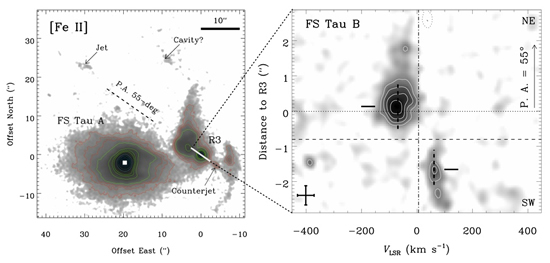Is FS Tau B Driving an Asymmetric Jet?

Left: near infrared [Fe II] 1.644 µm + continuum image of the wide binary FS Tau A and B. FS Tau B is not visible but its adjacent reflection nebula R3 is bright in continuum. Jet and counterjet driven from FS Tau B along 55 degrees are indicated.
Right: continuum-subtracted position-velocity diagram of FS Tau B jet in [Fe II] along the position angle of the jet. The position of the invisible driving source is indicated by the horizontal dashed line and the systemic velocity is labeled by the vertical dash-dotted line. The blueshifted and redshifted knots have velocities -74.6 and +55.8 km/s, respectively.
FS Tau B is one of the few T Tauri stars that possess a jet and a counterjet as well as an optically visible cavity wall. We obtained images and spectra of its jet-cavity system in the near-infrared H and K bands using the Subaru/Infrared Camera and Spectrograph and detected the jet and the counterjet in the [Fe II] 1.644 µm line for the first time. Within 2” the blueshifted jet is brighter, whereas beyond ∼ 5” the redshifted counterjet dominates the [Fe II] emission. The innermost blueshifted knot is spectrally resolved to have a large line width of ∼ 110 km/s, while the innermost redshifted knot appears spectrally unresolved. The velocity ratio of the jet to the counterjet is ∼ 1.34, which suggests that FS Tau B is driving an asymmetric jet, similar to those found in several T Tauri stars (e.g., HL Tau, RW Aur A, HH 30). Combining with optical observations in the literature, we showed that the blueshifted jet has a lower density and higher excitation than the redshifted counterjet. We suggest that the asymmetry in brightness and velocity is the manifestation of a bipolar outflow driving at different mass-loss rates, while maintaining balance of linear momentum. A full explanation of the asymmetry in the FS Tau B system awaits detail modeling and further investigation of the kinematic structure of the wind-associated cavity walls. (Liu et al. 2012, ApJ, 749, 62)